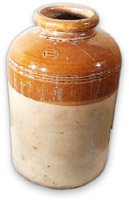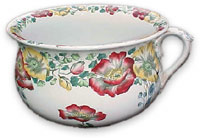The butter crock has evolved over the years. Historically, a butter pot was a different type of container. It was a large, cylindrical or slightly bulbous vessel, taller than it is wide, used to store dairy products and carry butter to the markets. Large Norman butter pots date back to at least post-medieval Welsh borderland kiln-sites. They were cylindrical vessels with or without a handle, and often with internal glaze.
An example of early butter-pots, made in the 1640s, were unearthed in Burslem, center of the butter-pot industry from the earliest days. The Burslem pots were well made of common clay, without glaze, and were marked in "rude letters" Cartwright on a relief two inches in diameter. This was the warranty that the pots were of the proper size.
At that time shysters tried to hoodwink the butter-buying public by various means: false bottoms, or too heavy or too lightweight wares to insure proper weights of butter to the ultimate consumers. Finally, in 1670 Parliament passed a law that these utensils had to weigh not more than six pounds, had to hold fourteen pounds of butter, and were to be of hard quality to prevent them from absorbing water from the butter. To insure and/or enforce the law, surveyors (inspectors) were hired to spot-check the contents; so rather than depend on weight alone they used an auger-type "butter boare" which was inserted obliquely to the bottom, removed, and check/tested to assure that the butter the same all the way through. This was, after a fashion, an early day pure food act.
The right pot
|
|
Potter Frank Gosar’s grandmother told a slightly scandalous story from her childhood in Slovenia about a butter pot. There was an old woman in her village who made clarified butter to sell. She'd save the cream from her cows, churn the butter, then melt it on the wood stove and pour it into her old grey stoneware crock. Once a week, on market day, she'd go into town and sell butter by the scoop to all the housewives there.
Well, one day she sold all her butter early, before noon, so she had a little time to go looking at the other stalls in the market. In one booth she came across a lovely big pot, all painted in flowers, with handles on the side. She thought, "If my butter sells so well from my old grey pot, think how much faster it would sell from this pretty new one." And she bought the pot.\
You know what's coming, of course. The next market day, nobody bought any butter. The city women just giggled and pointed, and wouldn't tell her why. It fell to the gatekeeper at the end of the day to explain to her what a chamber pot was, and why it wasn't the best container for displaying and selling her butter.


